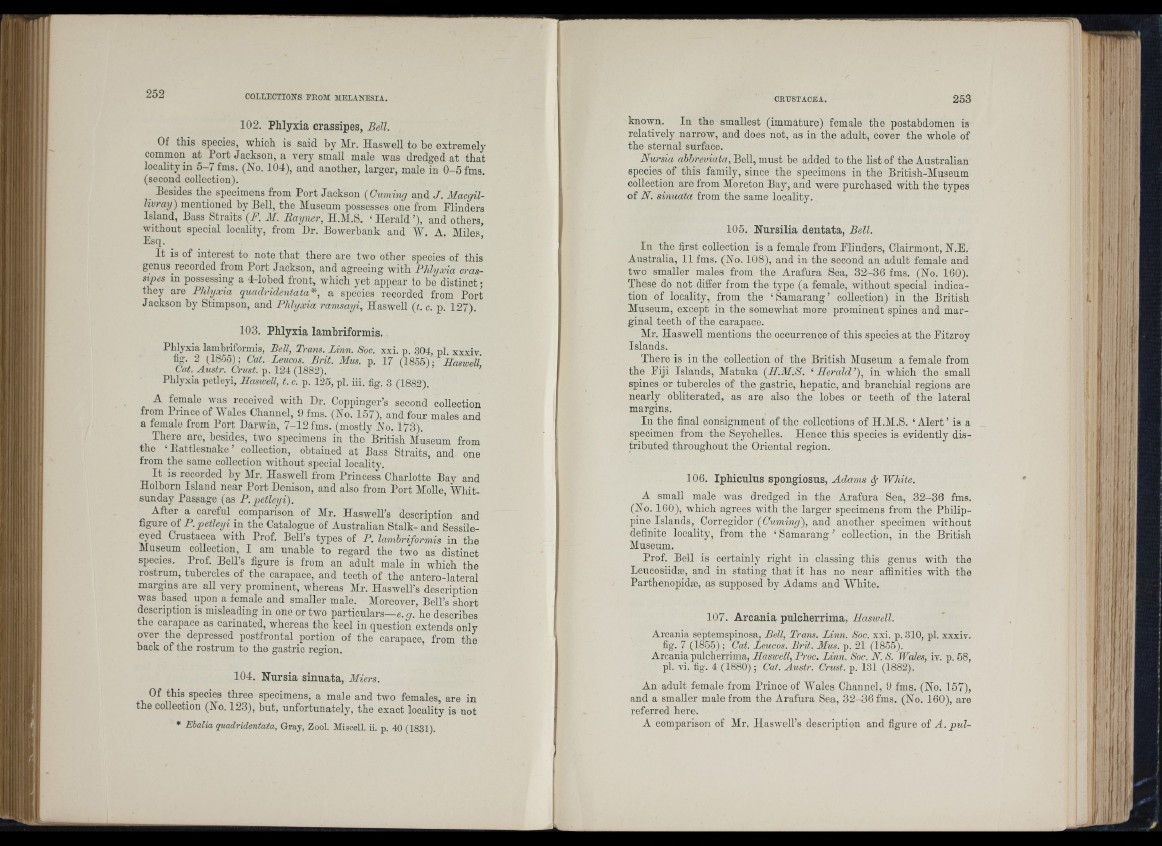
i».
102. Phlyxia crassipes, Bell.
Of this species, whieh is said by Mr. Haswell to be extremely
common a t Port Jackson, a very small male was dredged at that
locality in 5 -7 fms. (No. 104), and another, larger, male in 0 -5 fms.
(second collection).
_ Besides the specimens from Port Jackson (Cuming and J . Alacgillivray)
mentioned by Bell, the Museum possesses one from Plinders
Island, Bass Straits (F. AI. Rayner, H.Al.S. ‘ Herald ’), and others,
without special locality, from Dr. Bowerhank and AV. A. Miles
Esq. ’
I t is of interest to note th at there are two other species of this
geniis_recorded from Port Jackson, and agreeing with Phlyxia crassipes
in possessing a 4-lobed front, which yet appear to be distin ct;
they are Phlyxia quaclriclentata*, a species recorded from Port
Jackson by Stimpson, and Phlyxia ramsayi, Haswell (t. c. p. 127).
103. Phlyxia lamhriformis.
Phlyxia lambnformis, Bell, Trans. Linn. Soc. xxi. p. 304, pi. xxxiv.
fig. 2 (1855B Cat. Leiicos. Brit. Mus. p. 17 (1855); Hasivell
Cat. Austr. Crust, p. 124 (1882).
Phlyxia petleyi, Haswell, t. c. p. 125, pi. iii. fig. 3 (1882).
A female was received with Dr. Coppinger’s second collection
from Prince of AVales Channel, 9 fms. (No. 157), and four males and
a female from Port Darwin, 7-12 fms. (mostly No. 173).
There are, besides, two specimens in the British Aluseum from
the ‘Rattlesnake’ collection, obtained at Bass Straits, and one
from the same collection without special locality.
I t is recorded by Air. Haswell from Princess Charlotte Bay and
Holborn Island near Port Denison, and also from Port Molle AVliit-
sunday Passage (as P.petleyi). ’
After a careful comparison of Mr. Haswell’s description and
figure of P. petleyi in the Catalogue of Australian Stalk- and Sessileeyed
Crustacea with Prof. Bell’s types of P. lamhriformis in the
Museum collection, I am unable to regard the two as distinct
species. Prof. Bell’s figure is from an adult male in which the
rostrum, tubercles of the carapace, and teeth of the antero-lateral
margins are all very prominent, whereas Air. Haswell’s description
was based upon a female and smaller male. Aloreover, Bell’s short
description is misleading in one or two particulars—e.^. he describes
the carapace as carinated, whereas the keel iu question extends only
over the depressed postfrontal portion of the carapace, from the
back of the rostrum to the gastric region.
104. Nursia sinuata, Aliers.
Of this species three specimens, a male and two females, are in
the collection (No. 123), but, unfortunately, the exact locality is not
* Ebalia quadridentata, Gray, Zool. Miscell. ii. p. 40 (1831).
known. In the smallest (immature) female the postahdomen is
relatively narrow, and does not, as in the adult, cover the whole of
the sternal surface.
Nursia ahhreviata, Bell, must be added to the list of the Australian
species of this family, since the specimens in the British-Aluseum
collection are from Aloreton Bay, and were purchased with the types
of N. sinuata from the same locality.
105. Nursilia dentata, Bell.
In the first collection is a female from Elinders, Clairmont, N.E.
Australia, 11 fms. (No. 108), and in the second an adult female and
two smaller males from the Arafura Sea, 32-36 fms. (No. 160).
These do not differ from the type (a female, without special indication
of locality, from the ‘ Samarang ’ coUection) in the British
Museum, except in the somewhat more prominent spines and marginal
teeth of the carapace.
Air. Haswell mentions the occurrence of this species at the Eitzroy
Islands.
There is in the collection of the British Aluseum a female from
the Eiji Islands, Alatuka (H.M.S. ‘ Herald’), in which the small
spines or tubercles of the gastric, hepatic, and branchial regions are
nearly obliterated, as are also the lobes or teeth of the lateral
margins.
In the final consignment of the collections of H.M.S. ‘ Alert ’ is a
specimen from the Seychelles. Hence this species is evidently distributed
throughout the Oriental region.
106. Iphiculus spongiosus, Adams Sf White.
A small male was dredged in the Arafura Sea, 32-36 fms.
(No. 160), which agrees with the larger specimens from the Philippine
Islands, Corregidor (Cuming), and another specimen without
definite locality, from the ‘ Samarang ’ collection, in the British
Alusenm.
Prof. Bell is certainly right in classing this genus with the
Leucosiida?, and in stating th a t it has no near affinities with the
Parthenopidie, as supposed by Adams and White.
107. Arcania pulcherrima, Haswell.
Arcania septemspinosa, Bell, Trans. Linn. Soc. xxi. p. 310, pi. xxxiv.
fig. 7 (1855); Cat. Leucos. Brit. Mus. p. 21 (1856).
Arcania pulcherrima, Hasivell, Proc. Linn. Soc. N. S. Wales, iv. p. 58,
pi. vi. fig. 4 (1880) ; Cat. Austr. Crust, p. 131 (1882).
An adult female from Prince of AVales Channel, 9 fms. (No. 157),
and a smaUer male from the Arafura Sea, 32-36 fms. (No. 160), are
referred here.
A comparison of Mr. Haswell’s description and figure of A. p u l-
1 ,
\ 'i
r Iu
■'teii
!
f. I
il